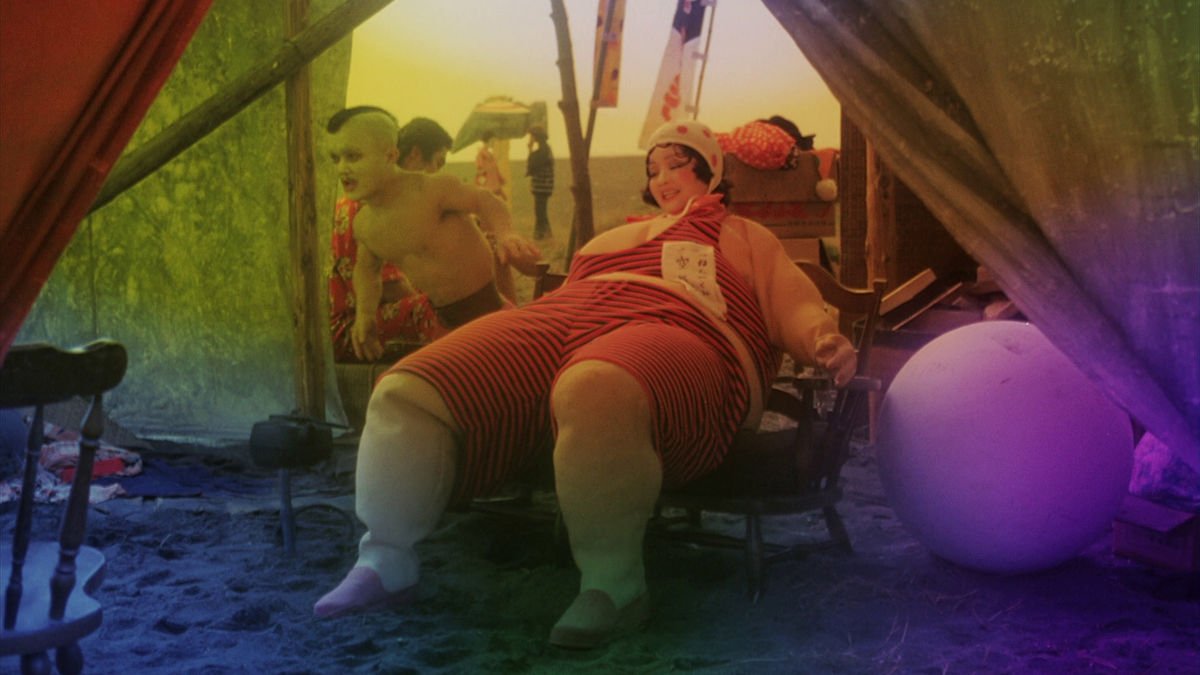
At 15, Shin-chan has to deal with growing up at the foot of a mountain that houses his father’s tomb, in the Aomori Prefecture of Japan. He lives with his mother, who is inexplicably angered after he exhibiting interest in the woman living next door, despite him openly speaking of his sexual thoughts to her. One day while living in the village, he witnessed a woman giving birth to a child. What shocked him the most, was that due to it being born outside wedlocks, the locals alienated the women. But in the face of societal exclusion, the women chose to live their lives seamlessly. As spring rolled in, a circus arrived in their town, where Shin-chan was awed by a woman performing in a fat suit that she himself wore and called for employees to strap while she was still in it.
There plots in the film suddenly change and look drastically different, specially due to an adult Shin, having been revealed to be directing the movie. As new perspectives are explored, it is realized that seeking monetization from memories or experiences of one’s childhood is nothing short of turning a sensitive topic into cheap entertainment.
A friend supplies a mental ‘solution’ in the course of a conversation, but shortly, the instructor finds his young self in the editing room. The events of the film move back in time, and so does Shin-chan with the director.
The idea of the film around the film is somewhat more complicated in its realization, but that is also just one segment of a context here which can only be described as labyrinthine. As time blends so do the boundaries of fiction and in this case reality, with Terayama literally talking about memory and especially the memory of children, which is not always quite accurate. Also, all the story locations we have mentioned above, are in fact just a small part of the said story, while Terayama is also adding a non-idealistic view which takes place mostly in the frightening mountain, whereas all the so called dancing, erotic, love, and even its abuse, and the idea of time alongside sex all come forth.
The act of voyeurism by Shin-chan is something that he indulges in consistently and this too is something that can be regarded as a director’s tool. Likewise, the woman with the baby is a polemics with regard to society as is the case with the notion of the woman who lives next door and is not happy with her marriage but cannot find the courage to leave.
The portrayal of these two protagonists alludes to a troubled and meaningless existence as does the bond that Shin has with his mother, which is somewhat Oedipal in nature, yet does not quite come to the fore. While this film has traces of iconoclasm and symbolism, the circus could mean a variety of things. Last of All, the ghosts, the group of women who seem to play the same role that the Chorus did in Greek Tragedies, and the actresses who paint their faces with white put forward a cult like atmosphere alongside the theatrical.
It is somewhat of an achievement that Terayama is still able to deliver a film with the aforementioned five aspects right, for it does look rather beautifully captivating while at the same time being coherent. Costume designer Ken Hoshina, make up artist Kiyoshi Awazu and many others did an exceptional job clothes and make up which ended up creating breath taking images and sets. Tatsuo Suzuki the wearing director of photography managed to capture all aspects of the film wonderfully while being experimental and artistic, and this is clearly visible in the many aspects of the movie, such as when the door of a home opens up to reveal a mountain.
It comes as no surprise that given how many plots there are, along with the ‘film within a film’ concept, Terayama worked alongside three editors: Hiroshi Arai, Sachiko Yamaji and Ryusuke Otsubo, as some scenes in the movie seem to go off in a rather experimental manner. The end product is as much bewildering as it is artistic, especially given how the film’s speed seems to change at an alarming rate only further establishing the previously mentioned ‘qualities’.
Not unsurprisingly, the moving pieces of the play followed a very similar set of guidelines to the movie’s rule, which is why many of the performers towards the more dramatic and stage like tone. But this ended up creating coherence with the overall theme.
Although trying to fit into the shoes of the role of young Shin-chan’s voice of the character Hiroyuki Takano is not an easy task, he does seem to manage fairly well, but on the contrary, acting quality can also be seen in Chigusa Tayama who portrays Fukiko’s mother with more of a ‘suffocating’ trait and Kaoru Chigusa who portrays the married aegyo: the neighbor and siren. Many intake kikoi the pregnant lady is also good for once in a while like a pregnant lady and the other time in desperation.
“To Die in the Country” is first of all a movie with astonishing visuals and a more than intriguing narrative, to die in the country is an experimental auto biography that also serves as an exercise in self-psychotherapy for tera Yama. Those films that definitely deserve more than one viewing in order to appreciate the completeness of what they are.
For more movies like Pastoral: To Die in the Country (1974) visit solarmovie.







